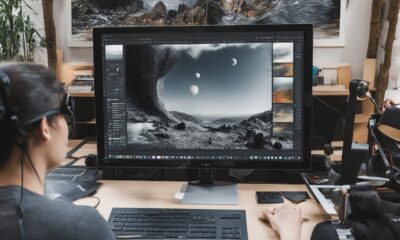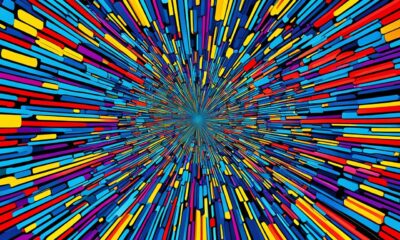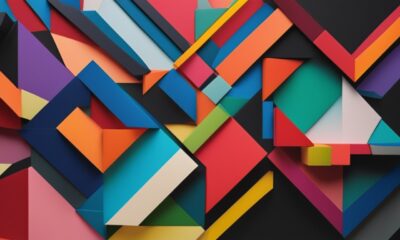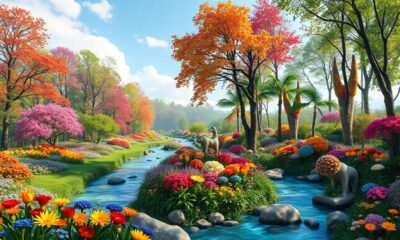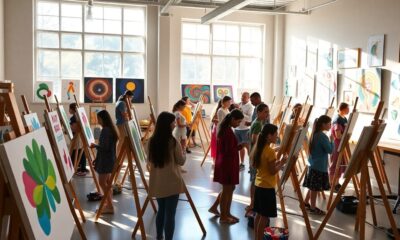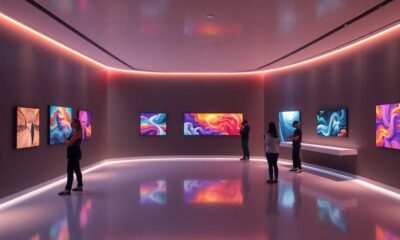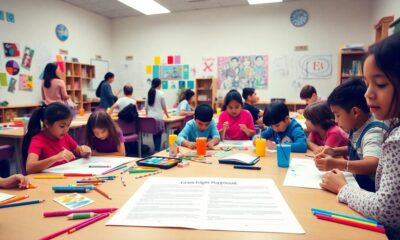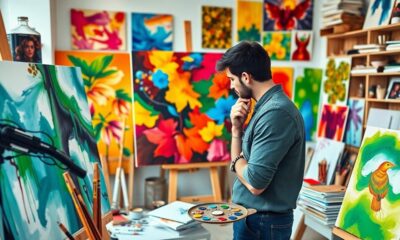Art
Exploring Performance Art Theory: A Guide
Dive into the nuances of performance art theory and understand how it shapes contemporary, experimental, and avant-garde art forms.
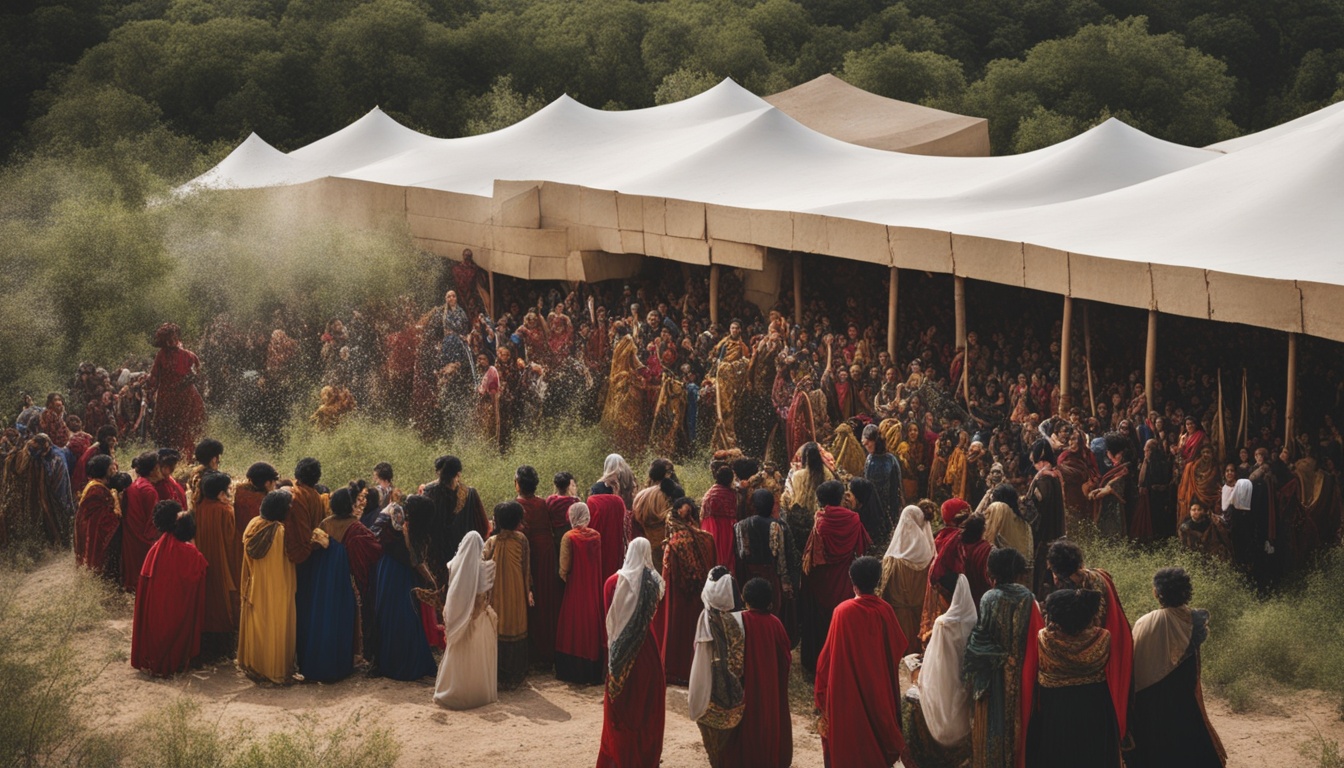
Have you ever found yourself captivated by an artistic performance that moved you in unexpected ways? The essence of performance art goes beyond mere entertainment; it challenges perceptions and evokes deep emotional responses. As you delve into the intricate layers of performance art theory, you’ll uncover a rich tapestry woven through history, philosophy, and personal expression. This guide aims to illuminate not just what performance art theory is, but also its profound implications on contemporary performance art and the society we inhabit today. Understanding this art form is more than an intellectual exercise; it’s a journey that invites you to reconsider the very boundaries of art and life.
Key Takeaways
- Performance art emerged in the United States during the 1950s and 1960s as a revolutionary form of expression.
- The genre challenges traditional art concepts by using the body as a medium and engaging real-time performance.
- Significant artists like Bobbie Baker, Orlan, and Robert Wilson have shaped the evolution of performance art.
- Avant-garde movements such as Dada and Fluxus laid the groundwork for the emergence of performance art.
- This art form focuses more on the process of creation than on the final product.
- Performance art theory combines practice with psychoanalytic critiques, offering new insights into live work.
- The interplay between artist and audience is pivotal in creating an immersive art experience.
Understanding Performance Art: A Historical Perspective
In examining the performance art history, one discovers its roots and evolution. This genre began gaining traction in the 1950s and 1960s, marking a departure from traditional artistic expressions and conventions. Emerging from earlier movements like Dadaism, performance art sought to create interactions between the artist and the audience, paving the way for what you see in contemporary performance art today.
The Origins of Performance Art
The very foundation of performance art can be traced back to events in the early 20th century, including cabaret performances and futurist productions. This era acted as a springboard for later explorations of body and space. By the 1960s, the genre focused heavily on the body, giving rise to what is often referred to as Body Art. Performance artists began using their bodies as primary tools to express provocative ideas and challenge norms.
Key Developments in Performance Art History
As the performance art movement matured, several key developments occurred. The decline of modernism and Abstract Expressionism led to an unprecedented flourishing in the 1960s. Events such as Yoko Ono’s Cut Piece in 1964 and Chris Burden’s Shoot in 1971 became landmark performances that pushed boundaries. Additionally, the provocative work of Vito Acconci in Seedbed in 1972 exemplified the daring nature of this art form, focusing on intimate relationships between performers and audiences.
Notable Artists and Their Contributions
A range of notable artists have contributed significantly to the development of performance art. Pioneers such as Carolee Schneemann and Marina Abramović pushed the limits of expression with their groundbreaking works. Contemporary figures like Tania Bruguera and Petr Pavlensky continue to explore and expand upon these traditional roots. Performance art remains an essential aspect of the modern art landscape, often challenging viewers to rethink the boundaries of creativity.
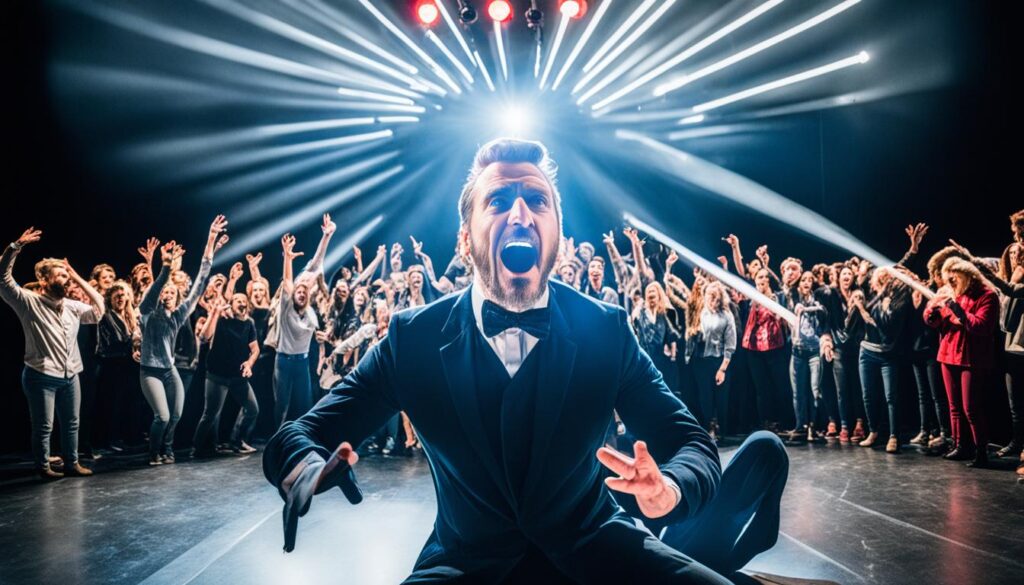
| Artist | Notable Performance | Year |
|---|---|---|
| Yoko Ono | Cut Piece | 1964 |
| Chris Burden | Shoot | 1971 |
| Vito Acconci | Seedbed | 1972 |
| Marina Abramović | The Artist Is Present | 2010 |
What is Performance Art Theory?
Performance art theory encompasses a variety of interpretations and methodologies surrounding this dynamic form of artistic expression. Understanding what is performance art theory requires delving into the distinct practices that differentiate it from traditional artistic disciplines like dance and drama. As the field evolves, different schools of thought emerge, contributing to the richness of performance art analysis. Some theorists focus on the body as the primary medium for performance art, while others emphasize the role of the audience in shaping the meaning of a performance. Additionally, with the rise of digital technology, more contemporary theorists explore new media art theory to understand how performance can intersect with virtual and augmented realities. These diverse perspectives and approaches to performance art theory contribute to a complex and multifaceted discourse on the nature and significance of this unique art form.
Defining Performance Art Theory
Performance art theory seeks to articulate the unique qualities that define performance as a distinct art form. Unlike static artworks, performance art often engages the body, space, and audience in real-time. This theoretical framework has grown significantly since performance art gained recognition as a legitimate art form in the 1950s, particularly at places like Black Mountain College, which became a breeding ground for interdisciplinary practices.
Different Schools of Thought
Within performance art theory, various schools of thought provide unique perspectives. Some theorists adopt a psychoanalytic approach, exploring the emotional and psychological dimensions of performance. Others focus on sociopolitical implications, viewing performance as a site of protest and resistance. Feminist artists in the 1960s played a crucial role in this dialogue, using performance to reclaim their bodies from historic male objectification. This cross-disciplinary nature invites collaboration across artistic formats, enhancing the depth of performance art analysis.
Performance Art as a Distinct Discipline
Recognizing performance art as a distinct discipline is vital to appreciating its transformative potential. It stands apart from other art forms due to its ephemeral nature, often testing the limits of human endurance. Artists like Joseph Beuys exemplify this endurance through daring performances, such as spending three days with a wild coyote. The political aspect of performance art cannot be overlooked, as seen in Pussy Riot’s Punk Prayer, which directly challenges authority and examines societal structures. The evolution of performance art theory is traced through notable publications and diverse voices that reflect a broad spectrum of ideas.

| Aspect | Details |
|---|---|
| Historical Context | Gained recognition in the 1950s, predominantly at Black Mountain College. |
| Key Contributors | Feminist artists, avant-garde movements, and notable theorists. |
| Focus Areas | Psychoanalysis, sociopolitical implications, and body-centric practices. |
| Notable Performances | Joseph Beuys and Pussy Riot as significant examples of endurance and protest. |
| Publication Influence | Key titles published between 1974 and 2011, shaping the theoretical landscape. |
Contemporary Performance Art: Trends and Techniques
Contemporary performance art encompasses a wide range of innovative approaches that redefine traditional artistic expressions. With the rise of experimental performance art, artists are continually exploring new ways to engage their audience and challenge established norms. The infusion of technology and multimedia elements creates a vibrant landscape that captures the spirit of avant-garde performance practices.
Exploring Experimental Performance Art
Experimental performance art invites artists to push boundaries, often leading to unexpected and immersive experiences for viewers. This type of art focuses on the ephemeral quality of live performances, requiring audience engagement during the creation of the piece. Artists utilize unique techniques to create works that resonate with their audience, transforming ordinary spaces into extraordinary art environments.
Avant-Garde Performance Practices
The world of avant-garde performance practices continually evolves, merging different artistic disciplines to question the nature of art itself. This blending of forms creates a rich tapestry of experiences, where traditional categories dissolve, allowing for greater creativity and exploration. Artists who adopt these practices not only reinvent what performance can be but also challenge societal conventions through their engagements.
Innovative Performance Art Techniques
Innovative techniques play a crucial role in shaping contemporary performance art. From incorporating interactive installations to site-specific performances, artists invite audiences to become active participants. These strategies foster a deeper connection between the artwork and the viewers, emphasizing the importance of shared experiences in the art-making process.

| Technique | Description | Notable Artists |
|---|---|---|
| Interactive Installations | Engages audiences directly, enabling them to influence the performance. | Yoko Ono, Marina Abramović |
| Site-Specific Performances | Utilizes a specific location to enhance the work’s narrative and impact. | Chris Burden, Richard Serra |
| Digital Integration | Incorporates technology to create immersive and lasting experiences. | Rafael Lozano-Hemmer, Jen Bervin |
Analyzing Performance Art: A Critical Lens
Engaging with performance art requires a discerning approach that merges aesthetic appreciation with contextual understanding. Performance art criticism serves as a vital tool for breaking down the complexities inherent in these works. By employing distinct methodologies, critics can unravel the multifaceted layers that define performance art, making performance art analysis not only insightful but also enriching for the audience.
Performance Art Criticism: An Overview
Performance art criticism encompasses various interpretations and methods used to evaluate key aspects of artistic expression. It draws attention to the significance of context, the artist’s intentions, and the audience’s reactions. To appreciate the transformative power of performance art, criticism must acknowledge its distinctive qualities. This art form challenges traditional norms, inviting audiences to be part of the dialogue. Such participatory experiences have fostered rich artistic landscapes, reflecting societal changes and cultural dialogues.
Tools for Performance Art Analysis
The process of performance art analysis necessitates a diverse set of tools. Observational techniques allow for a direct engagement with the artwork, while theoretical frameworks offer structured approaches to understanding. Some essential tools include:
- Documentary Analysis: Reviewing relevant videos, photographs, or scripts provides context and enhances understanding.
- Audience Response Studies: Gathering audience feedback contributes to examining the impact and reception of performances.
- Comparative Analysis: Evaluating works against other performance art pieces illuminates common themes and influences.
Engaging with Psychoanalytic Perspectives
Psychoanalytic perspectives play a crucial role in performance art analysis, offering deeper insight into the meanings constructed through performance. Concepts such as Freud’s notion of ‘transference’ and Lacan’s theory of ‘repetition’ allow viewers to explore the emotional and psychological layers embedded within the artwork. When analyzing performances through these lenses, one can uncover profound connections between the artist’s expressed identity and the audience’s interpretation. Such explorations further invite a critical engagement with the socio-political contexts that shape performance art.
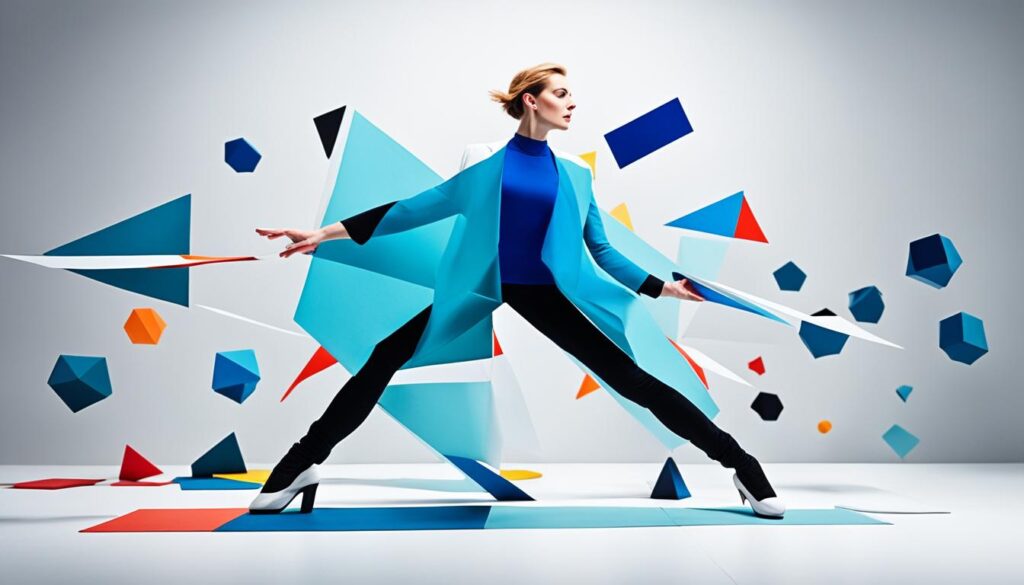
Conclusion
In summary, what is performance art theory? It’s a rich and multi-dimensional framework that allows you to explore this dynamic art form beyond conventional boundaries. Tracing its roots in performance art history reveals a progression from the experimental approaches of the 1960s and 1970s to the contemporary performance art landscape we see today. The incorporation of various artistic disciplines, like dance and music, has enriched this genre, making it a vibrant medium of expression.
As you delve into the evolution of performance art, the contributions of influential figures such as Marina Abramović, Vito Acconci, and Oskar Schlemmer become more apparent. Their innovative approaches have not only defined the characteristics of performance art but also paved the way for a new generation of artists who continuously push the boundaries of this engaging form. Performance art emphasizes live, ephemeral experiences, inviting immediate interaction with audiences in ways that traditional art forms often do not.
Engaging with contemporary performance art allows you to reflect on broader cultural narratives while enhancing your appreciation for the craft itself. It provides a platform for dialogue and connection, challenging you to consider the interplay between the artist and viewer. By understanding what is performance art theory, you uncover the significant role this art form plays in shaping modern artistic practices and, ultimately, your interpretation of the world around you.
FAQ
What is performance art?
How has performance art evolved over time?
Who are some notable performance artists?
What are some common techniques used in performance art?
How can I analyze performance art effectively?
What distinguishes performance art from other art forms?
What role does audience interaction play in performance art?
What is the significance of historical context in performance art?
Special Topics
Environmental Themes in Art
With artists like Andy Goldsworthy and Agnes Denes, explore how environmental themes in art provoke thought and inspire action for a sustainable future. What will you discover?

Environmental themes in art focus on raising awareness about ecological issues and human impact on nature. You'll see artists like Andy Goldsworthy use natural materials to create stunning pieces that emphasize sustainability. Many artists engage with local ecosystems, inviting public participation and collaboration to challenge traditional views. Projects like Agnes Denes' Wheatfield, a Confrontation spark important discussions about food security and climate change. By blending creativity with activism, these works encourage you to reflect on the relationship between art and the environment. There's much more to uncover about how art influences ecological consciousness and inspires change.
Key Takeaways
- Environmental art emerged in the late 20th century, responding to pollution and climate change through various artistic forms.
- Key artists like Andy Goldsworthy and Agnes Denes use natural materials to raise awareness about ecological issues and sustainability.
- Site-specific works transform landscapes into reflections on conservation, emphasizing public engagement and collaboration with local communities.
- Art serves as a powerful tool for advocacy, inspiring change and fostering dialogues about environmental responsibility through impactful projects.
- Future directions in environmental art include eco-friendly practices, technological integration, and influencing public policy on conservation efforts.
Overview of Environmental Art

Environmental art has taken off since its emergence in the late 20th century, focusing on ecological issues and human impact on the planet. This movement uses various artistic forms to raise awareness about pressing environmental concerns.
You'll notice that artists often work with natural materials, creating site-specific installations that blend seamlessly into their surroundings. Think of Andy Goldsworthy, who crafts ephemeral sculptures from leaves, stones, and twigs, or Agnes Denes, who combines art and activism to tackle pollution and environmental degradation.
As you explore this art form, you'll see how it transforms landscapes into reflections on conservation and sustainability. Notable large-scale installations, like Robert Smithson's "Spiral Jetty," challenge traditional notions of art, inviting viewers to engage with the environment in profound ways.
The beauty of environmental art lies in its ability to connect you with nature while prompting critical conversations about ecological responsibility.
Today, this movement continues to evolve, incorporating technology and fostering collaboration between artists and scientists. By doing so, it addresses urgent ecological issues and influences public perception, making environmental art a crucial force in the quest for a sustainable future.
Historical Context of Environmental Art
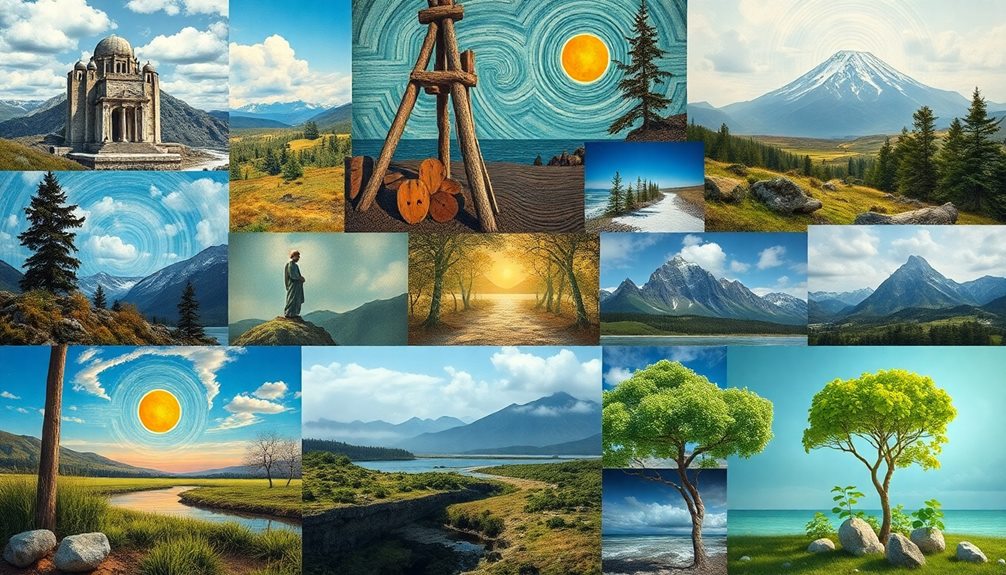
Environmental art emerged in the 1960s as a direct response to growing concerns about pollution and climate change.
This movement was heavily influenced by the activism of the time, pushing artists to engage with ecological issues in meaningful ways.
As you explore this historical context, you'll see how these artists transformed their work into a call for environmental awareness and action.
Emergence in 1960s
In the 1960s, amidst growing concerns about pollution and climate change, artists began to engage deeply with ecological issues through their work. This period marked a significant shift in the art world, where the focus changed from aesthetic beauty to addressing the relationship between humans and the natural world.
Here are three key aspects of this emergence:
- The rise of environmental crises highlighted the urgency for artistic expression that critiques ecological degradation.
- Significant events, like the first Earth Day in 1970, spurred public awareness and activism surrounding environmental issues.
- Artists such as Robert Smithson, with works like "Spiral Jetty," utilized natural materials to create site-specific installations that challenged conventional practices.
Early examples of environmental art included land art and eco-art, which emphasized using the environment as both medium and message.
This movement prompted a reevaluation of art's role in society, urging viewers to reflect on their impact on the climate and the planet. By engaging with these themes, artists not only contributed to the discourse on environmental conservation but also inspired a deeper connection to the natural world.
Influences of Activism
Artistic movements in the 1960s were profoundly influenced by the surge of environmental activism, as artists sought to reflect and address the pressing ecological crises of their time. This newfound awareness of natural and social issues propelled the emergence of environmental art, with artists like Agnes Denes and Robert Smithson leading the charge. They used their work to comment on pollution and climate change, advocating for restoration and conservation efforts.
As the movement gained momentum in the 1990s, artists began to perceive their surroundings as interconnected systems, intertwining art with ecological concerns. This shift allowed them to tackle social and political issues through their creations, making art a powerful tool for activism.
Significant exhibitions and literature emerged, reinforcing the understanding of environmental themes in art and showcasing how artists can catalyze change.
Today, you can see the lasting impact of this activism in contemporary works that continue to challenge and inspire. By engaging with these pieces, you're not just appreciating art; you're participating in a broader dialogue about our responsibility toward the environment, urging society to confront its ecological impact.
Key Characteristics and Aims

The essence of environmental art lies in its commitment to sustainability and ecological awareness. This movement not only highlights pressing environmental issues but also aims to inspire action and foster a deeper connection to nature.
Here are three key characteristics:
- Sustainable Materials: Artists frequently use materials like earth, stones, and leaves, emphasizing the importance of ecological integrity in their work.
- Site-Specific Works: Many projects are tailored to local ecosystems, encouraging you to engage more intimately with your surroundings.
- Public Participation: Collaboration within communities is crucial, as artists seek to involve people in their projects, merging art with activism.
Environmental art challenges traditional norms by transforming overlooked spaces and materials. It prompts you to reevaluate humanity's relationship with nature and consider your role in environmental preservation.
By addressing issues such as pollution, global warming, and deforestation through artistic expression, this movement fosters awareness and encourages activism.
Ultimately, environmental art serves as a powerful tool for change, inviting you to reflect on your connection to the planet while inspiring collective action for a more sustainable future.
Notable Environmental Artists

Notable environmental artists like Andy Goldsworthy and Agnes Denes shape the conversation around nature through their impactful works.
You'll see how their artistic contributions not only highlight ecological issues but also inspire activism and collaboration in the art community.
Let's explore the lasting influence these artists have on both art and environmental awareness.
Key Artistic Contributions
Throughout history, various artists have embedded environmental themes into their work, making significant contributions to the dialogue surrounding nature and sustainability. Here are three key artistic contributions you should know about:
- Andy Goldsworthy creates ephemeral sculptures using natural materials, like leaves and stones, to celebrate the beauty of nature, as seen in Pinfold Cones.
- Agnes Denes initiated Wheatfield, a Confrontation in Manhattan, cultivating wheat to raise awareness about food production and environmental issues.
- Robert Smithson is a pivotal figure in land art, best known for Spiral Jetty, which merges art and landscape, emphasizing the relationship between human intervention and natural processes.
These artists haven't only highlighted the beauty of our environment but also addressed pressing issues like climate change and biodiversity.
Olafur Eliasson engages viewers with immersive installations such as The Weather Project, while Herman de Vries uses natural materials to promote awareness of ecological systems.
Each of these artists contributes to a broader understanding of our connection to nature, urging you to reflect on your role in the environment.
Environmental Activism Through Art
Artists have long used their work to advocate for environmental causes, blending creativity with activism to spark awareness and inspire change. Notable environmental artists like Andy Goldsworthy create ephemeral artworks from natural materials, such as ice and leaves, showcasing the beauty and transience of nature. His work embodies the principles of environmental activism, emphasizing the need to cherish and preserve the environment.
Agnes Denes, a pioneer in this field, planted a two-acre wheat field in downtown Manhattan in 1982. This iconic piece, Wheatfield, a Confrontation, raised awareness about food production and environmental issues.
Similarly, Joseph Beuys initiated the 7000 Oaks project, where he planted 7,000 oak trees in Kassel, Germany, promoting ecological restoration and community involvement.
Robert Smithson's Spiral Jetty utilized the natural landscape of the Great Salt Lake to explore the relationship between art, nature, and human intervention, prompting essential dialogues about ecological awareness.
Impactful Collaborative Projects
In the domain of environmental art, impactful collaborative projects have emerged as powerful vehicles for raising awareness and fostering community engagement.
These projects often invite you to reflect on pressing environmental issues, like climate change, while celebrating the beauty of our natural world. Here are three notable examples:
- Agnes Denes' Wheatfield, a Confrontation: This two-acre wheat field in Manhattan sparked discussions about food security and environmental sustainability.
- Olafur Eliasson's The Weather Project: By creating an artificial sun in the Tate Modern, Eliasson engaged visitors in thoughts on nature's representation within urban settings.
- Andy Goldsworthy's Temporary Artworks: Using natural materials like stones and leaves, Goldsworthy emphasizes nature's beauty and its impermanence, as seen in works like Pinfold Cones.
These artists demonstrate that art often transcends aesthetics, driving conversations and inspiring action.
Collaborative projects encourage you to engage with your environment and challenge societal norms.
Case Studies in Environmental Art
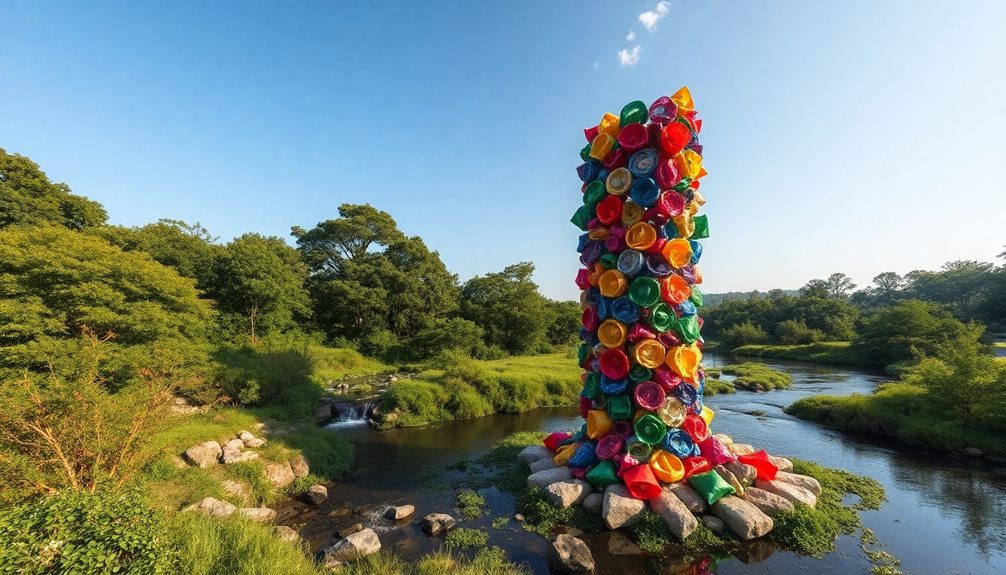
Environmental art often serves as a powerful lens through which we can explore the relationship between humanity and the natural world. Take Christo and Jeanne-Claude's "The Gates," for example. Installed in Central Park in 2005, it featured 7,503 saffron-colored fabric gates that drew over 4 million visitors, sparking discussions about urban space and public art.
Similarly, Andy Goldsworthy's ephemeral sculptures, like "Storm King Wall," utilize natural materials and highlight the transient beauty of nature, reflecting on human impact and environmental degradation.
Olafur Eliasson's "The Weather Project" at Tate Modern immerses visitors in a giant sun and mist, prompting reflection on climate change and our connection to nature.
Ebrahim Noroozi's photojournalism captures the decline of Lake Urmia, documenting environmental degradation and raising awareness about climate change's effects on local communities.
Lastly, Agnes Denes' "Wheatfield, a Confrontation" juxtaposes urban life with agriculture by planting two acres of wheat in Manhattan, emphasizing sustainability and resource use.
These case studies reveal how environmental art not only raises awareness but also encourages us to contemplate our responsibilities toward nature and our role in shaping a sustainable future.
Impact of Climate Change on Art
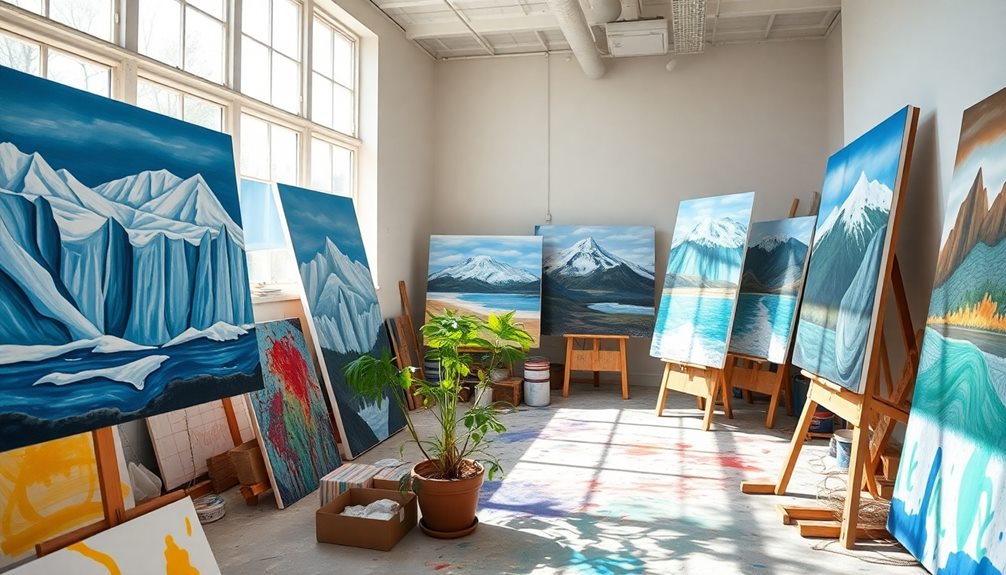
The urgency of climate change is reshaping the art world, pushing creators to confront pressing environmental issues in their work. Artists now address the following critical themes:
- Environmental Degradation: Works of art document the destruction of natural landscapes.
- Rising Sea Levels: Creators illustrate the threat to coastal communities through powerful imagery.
- Biodiversity Loss: Art highlights the extinction of species, fostering public awareness.
The impact of climate change is evident as artists increasingly use natural materials to emphasize their messages. By incorporating items from the environment, they create tangible connections between their art and the ecological crises we face.
This approach not only enhances the aesthetic quality of their works but also deepens the emotional resonance with viewers.
For instance, artists like Ebrahim Noroozi employ photojournalism techniques to showcase the decline of Lake Urmia, crafting rich visual narratives that raise awareness of climate change effects.
Through their innovative styles, these artists encourage community engagement and inspire action towards sustainability.
In doing so, environmental art becomes a powerful medium for communicating the urgent realities of climate change, urging us all to reflect and respond.
Future Directions in Environmental Art

A growing number of artists are embracing innovative approaches to tackle environmental issues, signaling a transformative shift in the art world.
You'll notice that sustainability is at the forefront of these new artistic endeavors, with creators adopting eco-friendly materials and practices to minimize their environmental impact. As climate change remains a pressing concern, artists are increasingly utilizing natural materials, ensuring their work resonates with ecological values.
Furthermore, the integration of technology is changing the landscape of environmental art. Through digital media and interactive installations, artists can convey complex issues while engaging wider audiences.
You might also find that collaborations between artists and environmental scientists are becoming more common, enhancing public understanding of ecological challenges and driving actionable change.
These artworks are influencing public policy, sparking conversations about urgent conservation efforts.
Frequently Asked Questions
How Can You Relate Art With the Environment?
You can relate art to the environment by observing nature's beauty, using natural materials, and creating works that inspire awareness. Your creations can provoke thoughts about sustainability and our connection to the world around us.
What Is the Theme of Nature in Art?
Imagine vibrant landscapes contrasting with urban chaos; nature in art captures beauty and chaos, inviting you to reflect on your relationship with the environment and discover deeper meanings behind every brushstroke and detail presented.
What Is Environmental Design in Art?
Environmental design in art creates spaces that blend with nature, using sustainable materials. You engage with local ecosystems, fostering connections through site-specific works. This approach encourages collaboration, enhancing public spaces while promoting ecological awareness and community involvement.
What Is Natural Environment in Art?
Imagine walking through a forest and seeing a breathtaking landscape painting. The natural environment in art captures nature's beauty and complexity, inviting you to explore your connection to the earth and reflect on its significance.
Conclusion
To sum up, environmental art serves as a powerful reminder of our connection to nature, much like roots intertwining with the earth. It reflects our struggles and hopes for a sustainable future, urging us to take action. As artists continue to respond to climate change, expect to see innovative works that challenge perceptions and inspire change. Embracing these creations not only enriches our lives but also strengthens our commitment to protecting the planet for generations to come.
Special Topics
Cross-Cultural Art Analysis
Step into the world of cross-cultural art analysis and discover how diverse artistic expressions intertwine to reveal profound connections waiting to be explored.
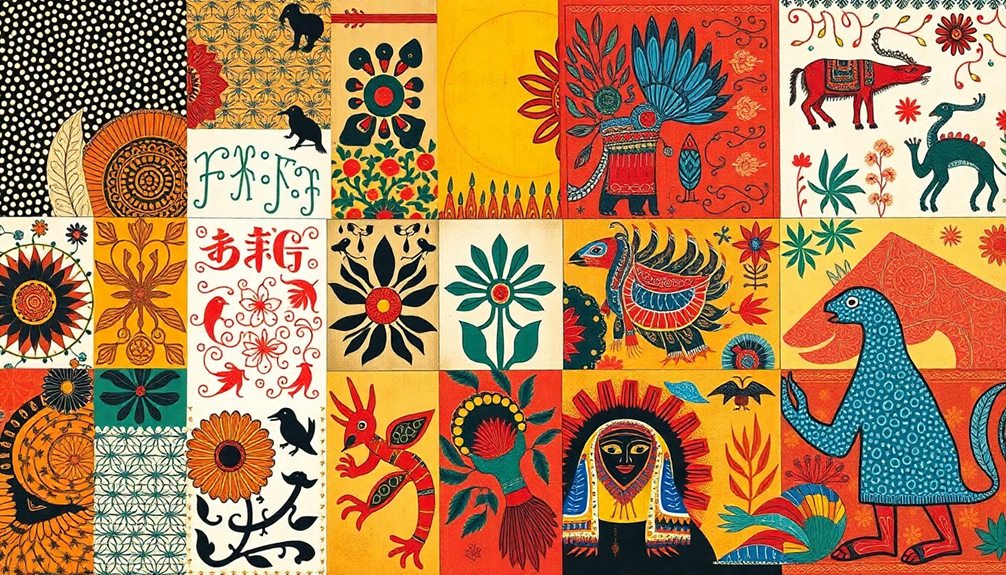
Cross-cultural art analysis helps you appreciate the vast array of artistic expressions that span different cultures and eras. By examining historical influences and shared themes, you'll uncover the ways various societies have contributed to art. You'll find intriguing examples of artistic syncretism that blend styles and techniques, revealing deeper meanings behind colors and symbols. This exploration also highlights the emotional responses art evokes in various cultural contexts. Plus, it's essential for modern education, fostering understanding and empathy. The journey doesn't end here; you can explore even more fascinating aspects of art's cultural connections.
Key Takeaways
- Cross-cultural art analysis examines artistic expressions across cultures, revealing shared themes like pilgrimage and religious devotion.
- Historical cultural exchanges, such as the Crusades, have significantly influenced artistic traditions and techniques in Europe.
- Artistic syncretism merges diverse cultural elements, resulting in hybrid styles and innovative practices seen in contemporary art.
- Emotional responses to art are shaped by cultural contexts, affecting interpretations of colors, forms, and storytelling methods.
- Future art analysis will leverage advanced technologies to explore the impact of globalization and emphasize non-Western contributions to art history.
Definition of Cross-Cultural Art Analysis

Cross-cultural art analysis explores the rich tapestry of artistic expressions across different cultures, revealing both shared influences and unique differences. This analytical approach examines how artistic traditions emerge and evolve through interactions among diverse cultures. By focusing on cultural influences, it highlights the ways in which art reflects the historical connections between societies, whether through trade, migration, or shared spiritual experiences.
Through cross-cultural analysis, you'll uncover common themes that resonate across geographical boundaries, such as pilgrimage and religious devotion. These themes demonstrate the universality of human experience, allowing you to appreciate how artistic expression can transcend cultural barriers. You'll see how art not only serves as a reflection of individual societies but also as a canvas for collaboration and innovation spurred by historical events.
Additionally, this analysis challenges Eurocentric narratives, fostering a more inclusive understanding of art history. By recognizing the interconnectedness of global artistic traditions, you can appreciate the richness that diverse cultures bring to the world of art.
This broader perspective encourages a deeper understanding of how art can unite rather than divide, celebrating the beauty of cultural exchange.
Historical Context and Influences

As you explore historical contexts, you'll notice how cultural exchange dynamics shaped artistic traditions.
The blending of styles, known as artistic syncretism, reveals the profound impact of interactions among diverse societies.
These influences not only enriched medieval art but also laid the groundwork for future artistic developments in the Renaissance.
Cultural Exchange Dynamics
Cultural exchange during the medieval period was a powerful force that transformed artistic landscapes across Europe and the Holy Lands. The Crusades greatly enhanced cultural exchange dynamics, paving the way for the fusion of diverse cultural elements.
As artisans traveled along historical trade routes, they shared ideas and techniques, leading to the incorporation of Islamic, Byzantine, and local Christian motifs in European art. You'd notice how illuminated manuscripts and intricate mosaics from this period showcase the syncretism achieved through these interactions.
New artistic practices emerged, such as the use of geometric patterns and calligraphy, fundamentally reshaping how artists approached their work. Common themes like pilgrimage, religious devotion, and sacred spaces echoed shared spiritual values, reflecting a rich tapestry of human experience.
The cross-cultural dynamics of the medieval era didn't just influence the art of the time; they laid the groundwork for future movements, including the Renaissance. You can see how these historical contexts resonate in contemporary artistic practices, reminding us that our creative expressions are often the result of ongoing dialogues across cultures.
Artistic Syncretism Patterns
During the medieval period, numerous artistic syncretism patterns emerged from the dynamic interactions among Islamic, Byzantine, and local Christian traditions. This blending often occurred during the Crusades, where cultural exchanges led to innovative artistic expressions.
You can see this in illuminated manuscripts and mosaics that beautifully combine geometric patterns with religious iconography. These works reflect a shared devotion and a deep-rooted connection among diverse cultural backgrounds.
Here are some key aspects of artistic syncretism during this era:
- Pilgrimage themes: Art often depicted journeys of faith shared by different cultures.
- Religious devotion: Common themes emerged, showcasing universal spiritual beliefs.
- Sacred spaces: Artistic representations of churches and mosques highlighted architectural influences.
- Trade routes: Historical exchanges through trade fostered new artistic styles.
- Renaissance influence: The legacy of medieval syncretism shaped European art, incorporating Islamic designs.
The fusion of these traditions not only enriched the artistic landscape but also laid the groundwork for future innovations, demonstrating how cultures can harmoniously coexist and influence one another through art.
Key Facts About Medieval Art
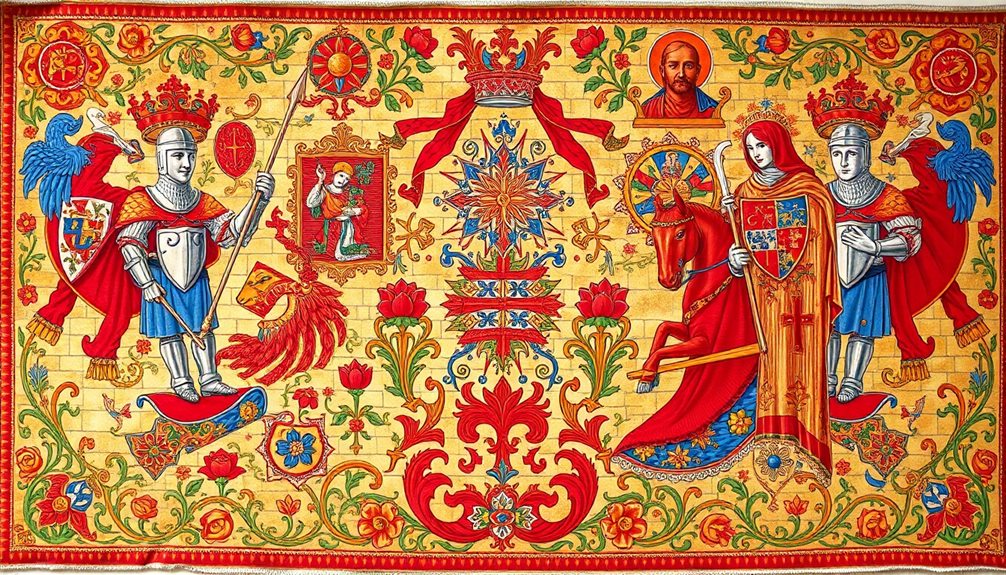
Medieval art, with its rich tapestry of influences, showcases a fascinating blend of Islamic, Byzantine, and local Christian elements. This artistic fusion created unique hybrid styles, particularly evident in illuminated manuscripts and stunning mosaics.
The Crusades played a pivotal role in enhancing cross-cultural exchanges, introducing new visual art techniques and motifs that greatly shaped European artistic expressions.
You'll notice common themes throughout medieval art, such as pilgrimage, religious devotion, and the portrayal of sacred spaces. These themes reflect the spiritual priorities of the time, emphasizing the importance of faith in daily life.
Artistic syncretism flourished during this period, as artists incorporated geometric patterns and intricate calligraphy from Islamic art into their own traditions, enriching their visual narratives.
The legacy of medieval art doesn't end there. Its cross-cultural influences continued to resonate in later artistic movements, particularly during the Renaissance, where artists drew inspiration from those earlier forms.
Cross-Cultural Artistic Techniques

When you explore cross-cultural artistic techniques, you'll notice how different traditions blend to create unique expressions.
Techniques like layering and collage showcase cultural fusion, while symbolism often crosses borders to convey deeper meanings.
This interplay of styles and methods enriches the art world, revealing the interconnectedness of global cultures.
Blending Artistic Traditions
Artistry often thrives at the crossroads of cultures, where diverse traditions intertwine to create something new and vibrant. You'll notice that blending artistic traditions often results from cultural exchanges that enrich the creative landscape.
For instance, the incorporation of Islamic geometric patterns into European Renaissance art illustrates how artists adapt and innovate.
Here are some key aspects of this blending:
- Syncretism: Artists merge different cultural elements to create hybrid styles.
- Illuminated Manuscripts: These works highlight the fusion of European and Islamic motifs, showcasing intricate designs.
- Trade Routes: Cultural exchanges along these paths introduced new materials and methods, like oil painting techniques.
- Shared Themes: Common motifs, such as pilgrimage and religious devotion, reveal how diverse artistic practices express universal human experiences.
- Historical Context: Events like the Crusades facilitated the exchange of artistic knowledge, blending Byzantine, Islamic, and local Christian influences.
Techniques of Cultural Fusion
Cultural fusion in art manifests through various techniques that creatively blend elements from distinct traditions. One prominent method is syncretism, where different artistic styles combine to create unique expressions, such as the hybrid designs found in medieval illuminated manuscripts.
You can see how cross-cultural exchanges influenced artistic techniques during the Renaissance, particularly in the way European artists incorporated geometric patterns and calligraphy from Islamic art. Additionally, studies have shown that engaging with diverse artistic expressions can enhance cognitive function and creativity, much like the benefits of listening to classical music.
Mixed-media approaches are another exciting avenue for cultural fusion. By using traditional materials from various cultures—like African textiles in conjunction with Western painting techniques—you create one-of-a-kind hybrid works.
Additionally, contemporary art often employs collage and montage, integrating diverse visual images and narratives from multiple cultural backgrounds.
Storytelling methods also play a significant role in cross-cultural artistic techniques. Many artists adapt narrative traditions, enriching their visual artworks by incorporating varied panel layouts from Japanese manga inspired by Western comic styles.
These techniques not only showcase the beauty of cultural fusion but also encourage you to explore the interconnectedness of global art forms.
Symbolism Across Cultures
How do symbols enrich our understanding of art across different cultures? They serve as a bridge, connecting you to the unique narratives and beliefs that define each culture. By examining the symbolism in art, you gain insights into the values and traditions that shape societies.
Consider these aspects of symbolism across cultures:
- Color meanings: Red symbolizes luck in Chinese culture, while in the West, it often signifies danger.
- Geometric patterns: In Islamic art, these patterns and calligraphy represent spiritual beliefs and the divine.
- Abstract designs: African art uses abstract forms to convey cultural narratives and community identity.
- Nature's harmony: Japanese art highlights the importance of living in balance with the environment.
- Narrative structures: Different storytelling techniques, like manga's unique panel layouts, contrast with Western comics and enhance artistic expression.
Understanding these symbols allows you to appreciate the depth of art across various cultures. Each piece tells a story, revealing how interconnected yet diverse human expression can be.
Embrace this exploration, and let the symbolism guide your artistic journey.
Symbolism Across Different Cultures

Symbolism is often a fascinating lens through which you can explore the diverse expressions of art across different cultures. Each culture imbues symbols with unique meanings, influenced by its historical and social contexts. For example, in Chinese culture, the color red symbolizes luck, while in the West, it often denotes danger. This illustrates how aesthetic judgments vary greatly between different cultures.
Shapes and motifs also carry distinct significance. In Native American art, the spiral represents growth, while in Celtic art, it symbolizes eternity. Similarly, Islamic art's geometric patterns reflect spiritual beliefs, embodying the infinite nature of Allah.
In Africa, abstract forms and masks represent ancestral connections and social roles, with each design signifying different tribes and their cultural traditions.
Japanese art uses symbols like cherry blossoms to illustrate the fleeting nature of life, capturing the essence of mono no aware, or the beauty in impermanence.
Emotional Responses to Art
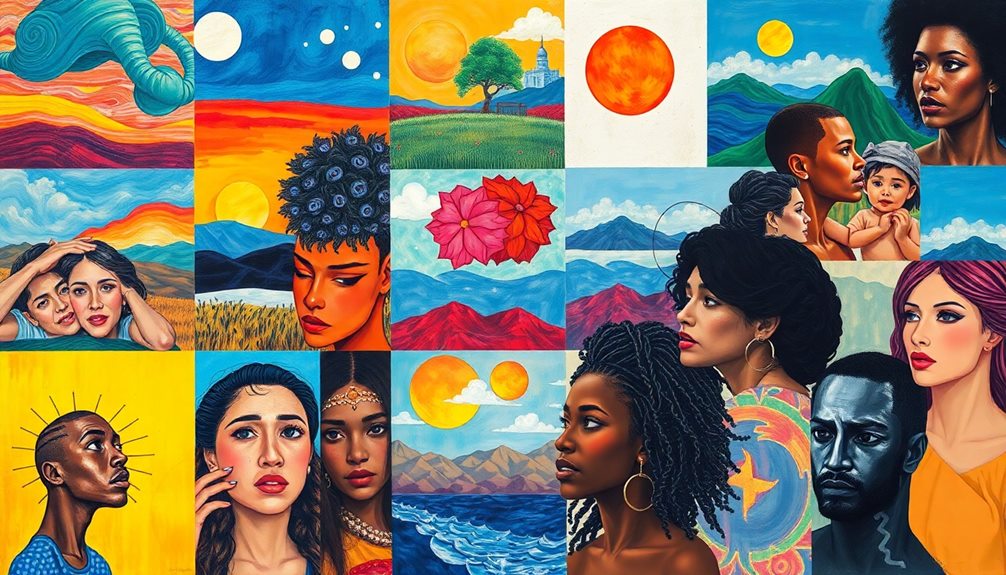
Art evokes a spectrum of emotions that can differ dramatically depending on your cultural background and personal experiences. Your emotional responses are shaped by cultural contexts, which influence how you interpret colors, forms, and themes in art.
For instance, while you might see red as a signal of danger, someone from a Chinese background may view it as a symbol of luck.
Understanding these diverse emotional reactions can deepen your appreciation for art. Here are some key points to reflect upon:
- Collectivist societies often focus on shared emotions, fostering community connections.
- Individualistic cultures highlight personal reflection, emphasizing deep emotional engagement.
- Japanese audiences may prefer simplicity and harmony in art.
- German viewers often seek complex pieces that express emotional depth.
- Art can cultivate empathy and understanding by exposing you to different cultural narratives.
Cultural Exchange and Artistic Innovation
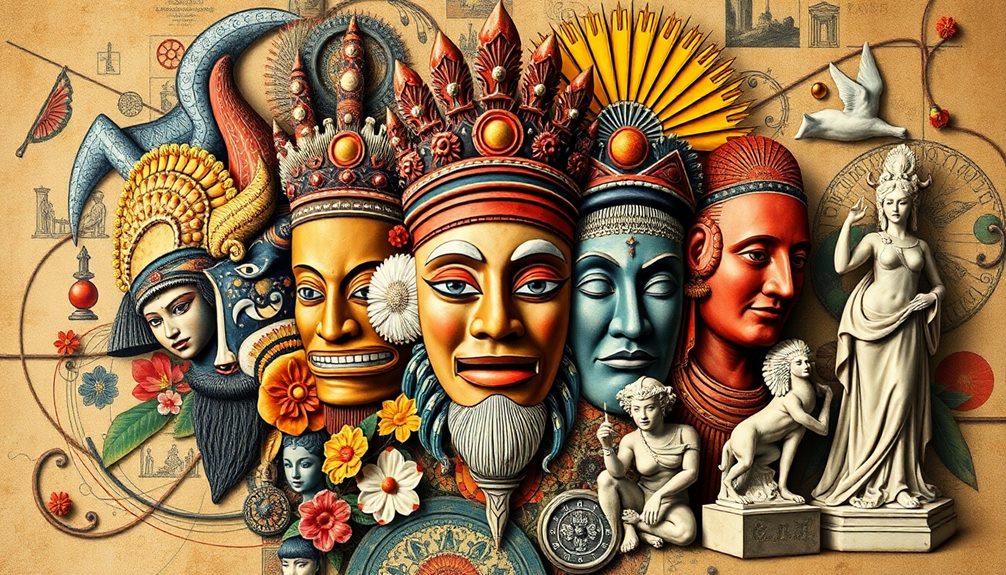
As you explore the historical contexts of cultural exchange, you'll notice how these interactions sparked innovative artistic practices.
The blending of styles from different traditions not only enriched the art of the time but also created unique expressions that resonated with diverse audiences.
Historical Contexts of Exchange
Cultural exchange has always sparked creativity and innovation, especially during the medieval period. The Crusades played a significant role in enhancing cultural exchanges between Europe and the Holy Lands. This led to a fascinating blend of Islamic, Byzantine, and local Christian artistic elements in medieval art. You can see this fusion in illuminated manuscripts and mosaics that exemplify hybrid artistic styles born from these interactions.
Key aspects of these historical exchanges include:
- The movement of artists across trade routes
- The blending of techniques and motifs
- Common themes like pilgrimage and religious devotion
- The creation of sacred spaces reflecting shared spiritual values
- Lasting influences on later artistic movements, such as the Renaissance
These cultural exchanges didn't just enhance artistry; they also fostered collaboration across different cultures, showcasing the power of creativity when diverse ideas come together.
The rich tapestry of medieval art stands as a symbol of how shared spiritual values and historical exchanges shaped artistic innovation, leaving an indelible mark on European art for generations to come.
Innovative Artistic Practices
Throughout history, innovative artistic practices have emerged from the rich tapestry of cultural exchanges, particularly during the medieval period. The Crusades acted as a catalyst, blending artistic styles that shaped European medieval art. You can see this influence in the intricate Islamic geometric patterns and Byzantine iconography that were integrated into various artworks.
Illuminated manuscripts and mosaics from the Holy Lands exemplify hybrid artistic practices born from these cross-cultural interactions. The adoption of techniques like calligraphy and elaborate tile work in European art highlights the significant role Islamic aesthetics played in shaping Western traditions.
Syncretism in medieval art led to common themes such as pilgrimage and religious devotion, which transcended cultural boundaries and enriched artistic narratives. Historical events and trade routes fostered artistic innovation, allowing artists to collaborate and draw inspiration from diverse backgrounds.
This melding of ideas not only created new styles and techniques but also cultivated a deeper appreciation for different cultures. As you explore these innovative artistic practices, you'll discover how cultural exchanges have profoundly impacted the evolution of art throughout history.
Implications for Modern Art
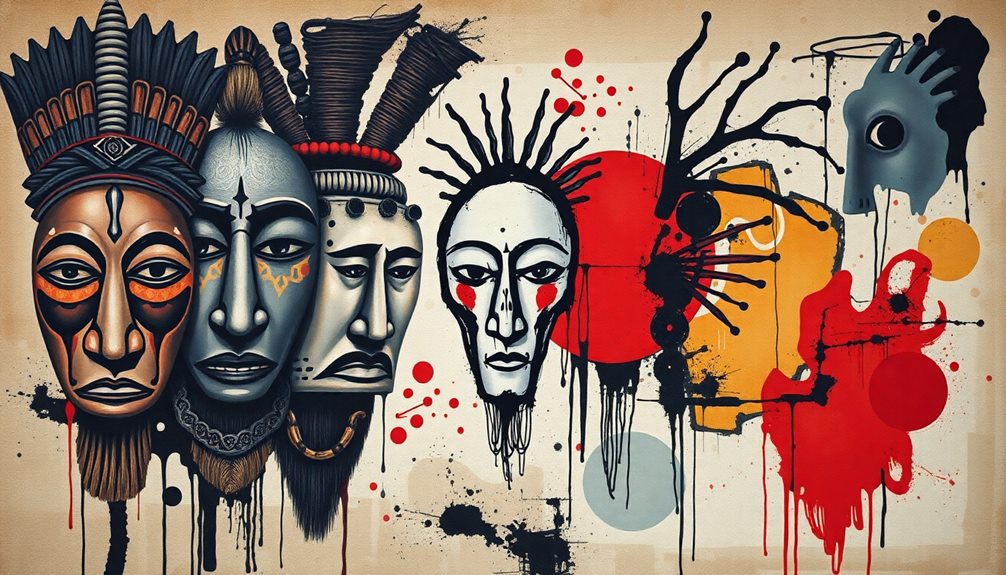
Modern art is reshaping itself by embracing diverse influences and breaking down traditional boundaries. This transformation is largely driven by cross-cultural interactions that foster new artistic expressions.
As globalization accelerates, artists draw inspiration from a variety of traditions, leading to innovative hybrid styles. This creates a rich tapestry of artwork that reflects shared human experiences and challenges conventional narratives.
Consider these implications for modern art:
- Cross-cultural collaborations enhance the creative process.
- Hybrid styles promote inclusivity and diversity in artistic expression.
- Digital platforms expand access to global audiences and cultural exchanges.
- Non-Western contributions gain recognition, reshaping art historical discourse.
- Artistic practices challenge Eurocentric perspectives and highlight interconnectedness.
Role of Art in Education
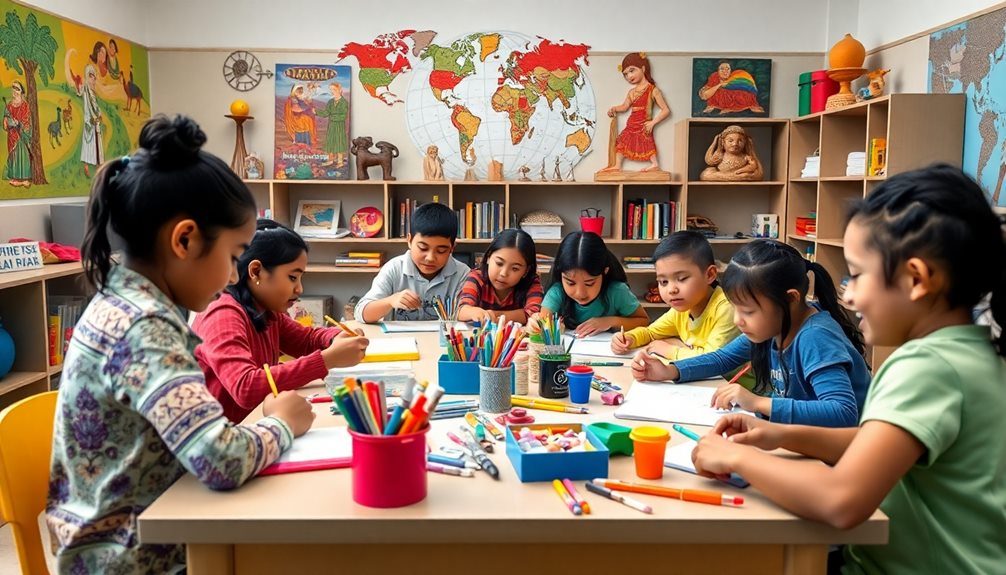
Art plays an essential role in education by introducing students to a variety of cultural traditions, which fosters appreciation for global diversity. When you engage with different art forms, you enhance your understanding of the lifestyles, values, and beliefs of various cultural groups. This exposure not only broadens your perspectives but also cultivates empathy and respect for diverse cultural approaches.
Research shows that art education leads to increased emotional connections among students, helping you relate to others' experiences. By challenging preconceived notions and biases, engaging with visual art promotes a deeper understanding of the struggles and joys of other cultures. This makes you more open-minded and sensitive to the complexities of the world around you.
Incorporating art into educational curricula contributes to holistic education, enriching your learning experience. It encourages cultural awareness, which is crucial in today's interconnected society.
Future Directions in Art Analysis
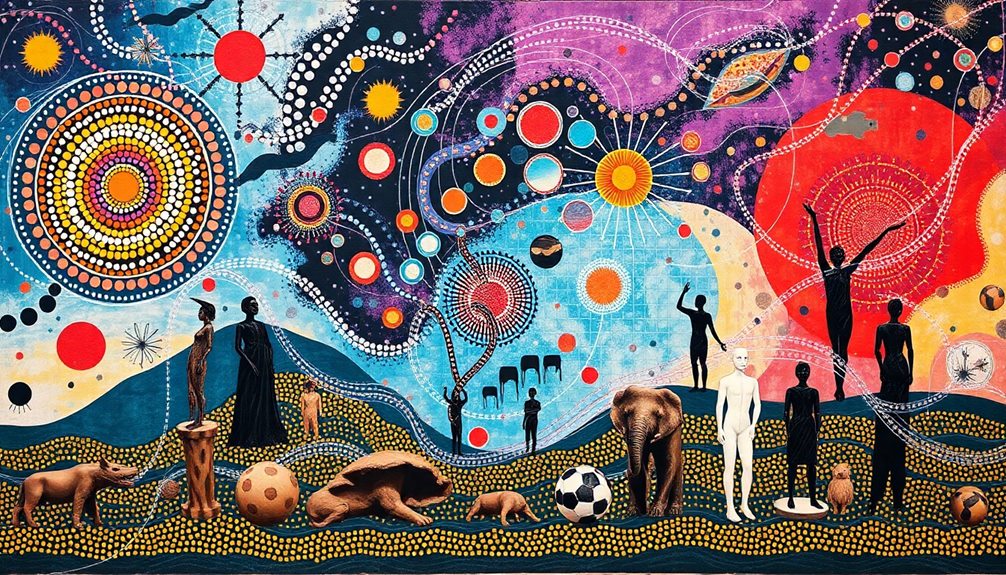
As education continues to embrace diverse cultural perspectives through art, future directions in cross-cultural art analysis promise to reshape our understanding of artistic expression.
You'll find that advanced technologies, like machine learning, will help unravel complex relationships between cultural contexts and aesthetic evaluations. This evolution will highlight the impact of globalization, revealing new hybrid styles born from the blending of different cultural influences.
Scholars will increasingly explore the significance of non-Western contributions, challenging traditional Eurocentric frameworks in art history. By integrating cultural relativism into art analysis, you'll gain a deeper understanding and respect for diverse artistic expressions and their meanings.
Future studies may focus on the emotional and psychological effects of art, enhancing empathy and intercultural dialogue within the global art community.
Here are some key areas to contemplate:
- Leveraging technology to analyze cultural contexts
- Exploring hybrid artistic styles from globalization
- Recognizing non-Western contributions to art narratives
- Promoting cultural relativism in art analysis
- Investigating emotional and psychological impacts of art
Frequently Asked Questions
What Is a Cross-Cultural Analysis?
A cross-cultural analysis examines how different cultures express ideas, values, and experiences through various mediums. It explores similarities and differences, helping you understand the broader context that shapes artistic practices and interpretations across diverse societies.
What Does Cross-Cultural Mean in Art?
In art, cross-cultural means exploring how different cultures interact, influencing each other's artistic expressions. You'll discover shared techniques, themes, and ideas, revealing the rich tapestry of global creativity that shapes our understanding of art today.
What Are the Methods of Cross-Cultural Analysis?
When you explore methods of analysis, think ethnography, visual techniques, and interdisciplinary frameworks. They blend qualitative and quantitative approaches, revealing patterns and preferences, helping you uncover the rich tapestry of cultural influences in art.
How to Do a Visual Art Analysis?
To do a visual art analysis, start by examining colors, shapes, and textures. Then, analyze composition and layout. Finally, reflect on your emotional response and how context influences your understanding of the artwork.
Conclusion
In exploring cross-cultural art analysis, you've uncovered the rich tapestry of influences and techniques that shape artistic expression. This journey reveals how cultures exchange ideas and innovate, enriching both historical and modern art. As you reflect on the symbolism and educational value of these artworks, consider: how can understanding diverse artistic traditions deepen your appreciation for creativity today? Embracing this knowledge not only enhances your perspective but also fosters a more inclusive view of the world through art.
Special Topics
Art and Mental Health
Creative engagement in art can unlock profound emotional healing, but how exactly does it transform mental health? Discover the impact it can have.
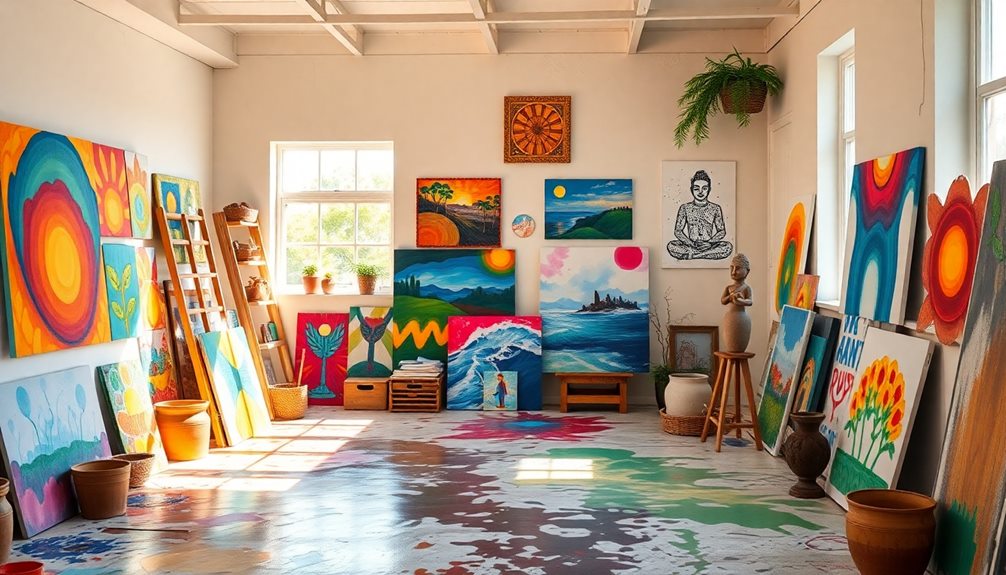
Engaging with art greatly boosts your mental health and emotional well-being. It allows you to express complex feelings non-verbally, providing a safe outlet for emotions. Whether it's painting, drawing, or participating in community art projects, these activities can reduce stress and anxiety while enhancing self-awareness. You'll find that art fosters a sense of accomplishment, promoting personal growth. Plus, art therapy effectively addresses mental health issues like depression and PTSD. By tapping into your creativity, you can access deeper connections with yourself and others, leading to emotional healing. Discover how art can transform your mental landscape further.
Key Takeaways
- Engaging with art enhances mindfulness, promoting present-moment awareness and reducing anxiety through focused creative activities.
- Art serves as a powerful non-verbal outlet for emotional expression, fostering deeper self-understanding and improving emotional intelligence.
- Creative activities provide significant stress relief, distracting from daily stressors and lowering cortisol levels through enjoyable artistic expression.
- Community art initiatives build social connections, reduce loneliness, and boost overall emotional stability through collective creative engagement.
- Creative arts therapy effectively addresses mental health issues, promoting healing through artistic expression tailored to individual emotional needs.
The Role of Art in Mindfulness
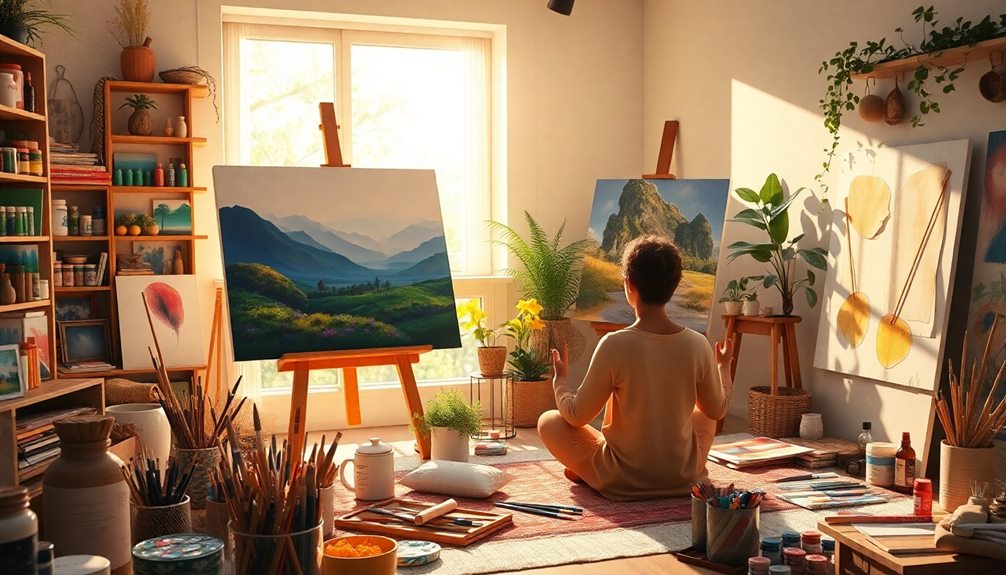
Have you ever noticed how engaging with art can pull you into the present moment? When you immerse yourself in creative activities like watercolor painting, you experience a state of flow where time seems to stand still. This process requires your full concentration, effectively quieting your mind and enhancing self-awareness—key components of mindfulness.
By focusing on the textures, colors, and forms, you cultivate a deep awareness that allows you to fully embrace the creative experience. Additionally, incorporating such practices can serve as a form of stress management, helping to alleviate anxiety and promote a sense of calm.
Regularly engaging in these artistic activities can greatly improve mental health. The repetitive motions involved in art can soothe your mind and lower cortisol levels, helping you find inner peace and reduce stress.
Studies show that even minimal, consistent creative practices can yield substantial mental health benefits, reinforcing the idea that art therapy is a powerful tool for enhancing mindfulness.
Emotional Expression Through Art

Art provides you with a unique outlet to express your emotions in ways words often can't capture.
By engaging in creative activities, you can communicate feelings like joy or sadness non-verbally, which can lead to deeper self-understanding.
This process not only helps you explore your emotions but also fosters a sense of accomplishment and boosts your overall well-being.
Artistic Outlets for Emotions
In the domain of emotional expression, artistic outlets serve as powerful tools for maneuvering complex feelings. When you engage in creative activities, you create a safe space to explore emotions like joy, sadness, and anger. This freedom allows you to express what's often difficult to articulate. Through art, you can gain insights into your feelings, enhancing your emotional intelligence.
Studies show that art therapy has proven effective for mental health conditions such as depression and PTSD. By facilitating emotional processing, it helps you understand and manage your experiences better. Additionally, the act of creating can greatly reduce stress and anxiety levels, promoting an overall sense of well-being.
Transferring emotions into art not only helps you process difficult feelings but also boosts your mood and self-esteem. You'll often find that seeing your emotions manifest in your work brings a sense of accomplishment, contributing to personal growth.
Non-Verbal Communication Benefits
Throughout history, creative expression has served as an essential means of non-verbal communication, allowing individuals to convey emotions that words often fail to capture. Engaging in art provides you with a powerful outlet for expressing complex feelings, whether it's joy, sadness, or anger. Without the constraints of language, you can explore and process these emotions more freely.
Studies show that art-making enhances emotional intelligence by fostering self-awareness and helping you identify and express your feelings. When you participate in creative activities like painting or drawing, you tap into therapeutic channels that can alleviate anxiety and depression, ultimately improving your emotional well-being.
Art therapy, in particular, proves beneficial for those facing communication challenges, such as individuals with trauma or mental health disorders. By creating art, you can share your experiences and emotions in a way that feels safe and accessible.
This form of non-verbal communication not only helps you articulate what might be difficult to say but also strengthens your emotional connections with others. Embracing art as a means of expression can be a transformative journey toward healing and understanding.
Art as a Stress Reliever

When you pick up a brush or pencil, the act of creating can instantly transport you away from daily stressors. Engaging in artistic activities like drawing or painting has been shown to lower cortisol levels, effectively reducing stress and anxiety.
Even a brief creative session, lasting just a few minutes, can provide significant mental health benefits, offering a valuable respite from the pressures of life.
The repetitive motions involved in art-making, such as the rhythmic strokes of painting, soothe your mind and promote relaxation, contributing to your overall well-being.
Studies indicate that individuals who regularly participate in creative activities report lower levels of stress and improved mood, emphasizing the therapeutic power of art.
What's essential is that the enjoyment derived from engaging in art, regardless of your skill level, plays a significant role in stress relief.
You don't need to be a professional artist to reap these benefits; the simple act of creative expression is accessible to everyone.
Benefits of Community Art Engagement
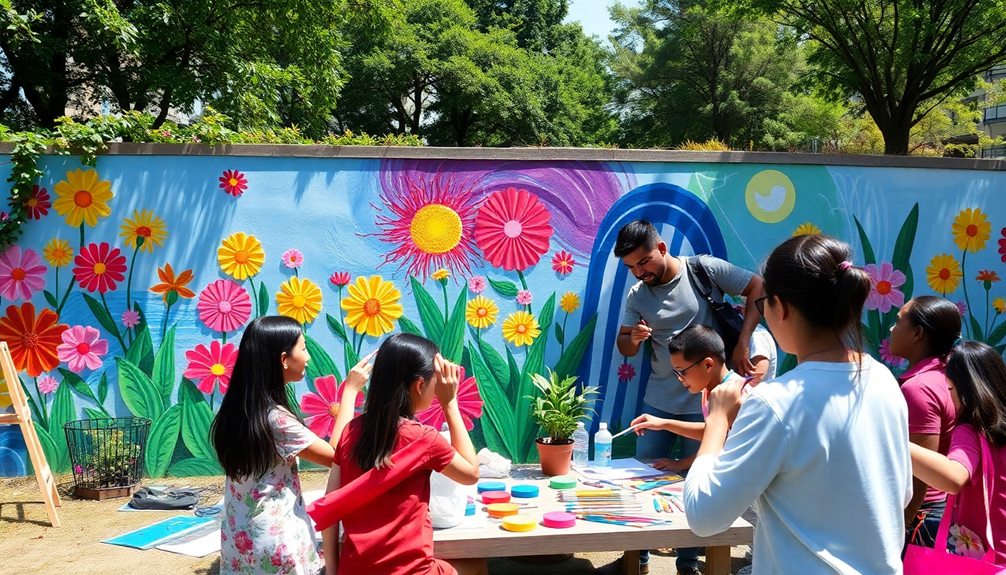
Community art engagement offers a profound sense of connection and belonging that can greatly enhance mental health. When you participate in community art programs, you're not just creating art; you're forming relationships and building support networks. This is especially vital for individuals facing mental health conditions, as it helps reduce feelings of loneliness and isolation.
| Benefits | Description | Impact on Mental Health |
|---|---|---|
| Improved Mood | Engaging in creative activities boosts overall well-being. | Enhances emotional stability and positivity. |
| Social Connections | Collaborative art fosters interactions among participants. | Reduces loneliness and builds friendships. |
| Emotional Expression | Art allows for expressing feelings that are hard to verbalize. | Lowers anxiety and stress levels. |
| Empowerment | Taking part in art projects gives a sense of ownership. | Increases resilience and self-esteem. |
Creative Arts Therapy Explained
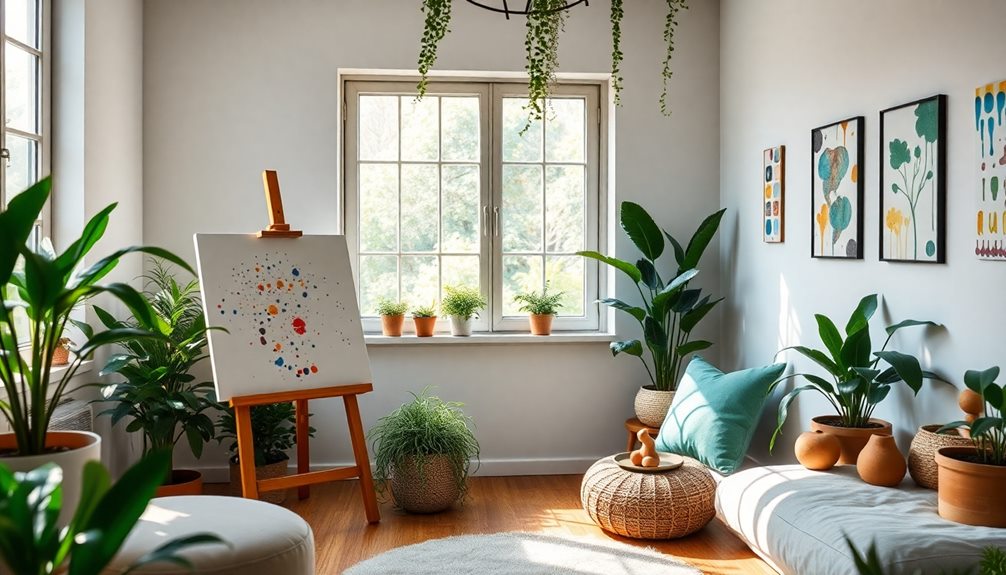
Creative arts therapy harnesses the power of artistic expression to promote healing and emotional well-being. This innovative approach includes activities like music, dance, writing, storytelling, collage-making, and painting, all tailored to meet specific clinical goals and your personal interests.
Originating in the 1940s, creative arts therapy has proven effective for various mental health problems, including anxiety, depression, mood disorders, schizophrenia, and dementia.
What's truly remarkable about this therapy is that success isn't measured by the quality of the art you produce but by your healing process and emotional expression. Research shows that engaging in creative arts therapy can greatly reduce anxiety and blood pressure, increase serotonin levels, and help you gain new perspectives on recovery.
Furthermore, creative arts therapy enhances your engagement during therapy sessions, improving your focus, emotional processing, communication skills, and self-esteem.
Healing Through Artistic Expression
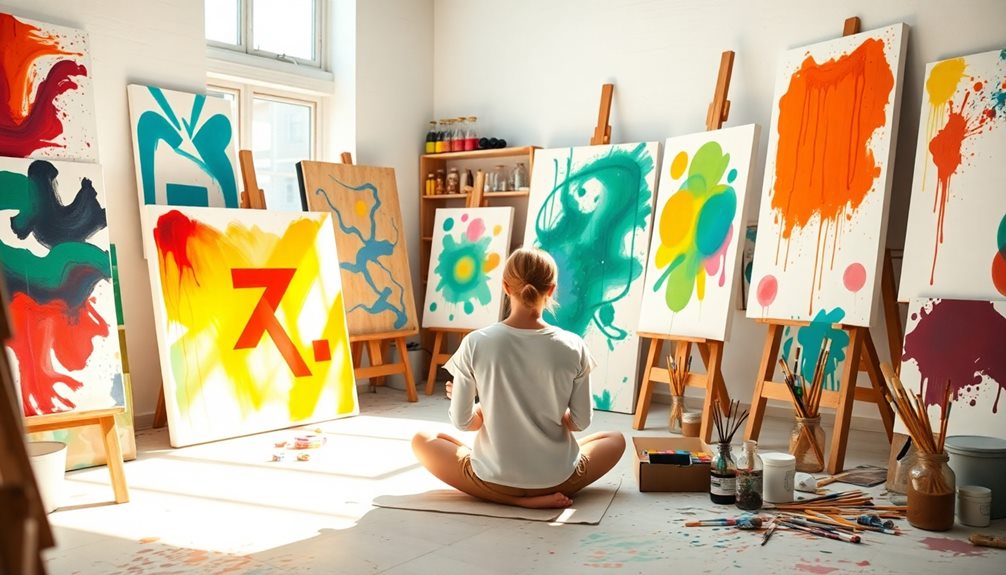
Artistic expression serves as a powerful outlet for healing, allowing you to navigate complex emotions and experiences that may feel overwhelming. Engaging in creative activities like painting, music, or storytelling can considerably improve your mental health.
Research shows that art can help reduce symptoms of anxiety and depression, particularly during vulnerable times like pregnancy and postpartum. In fact, the transformative power of curiosity can also enhance your creative endeavors, enabling you to explore new perspectives and ideas through art.
The creative process fosters emotional release, letting you explore feelings in a safe space. This can lead to enhanced self-esteem and better emotional processing, especially for those dealing with trauma or PTSD.
It's fascinating how consistent engagement in artistic activities, even for just a few minutes each day, can yield benefits akin to regular physical exercise.
Moreover, studies indicate that creating art not only alleviates anxiety but also helps manage pain perception, promoting better recovery in healthcare settings. By expressing yourself creatively, you allow for emotional healing and a deeper connection with your inner self.
Building Artistic Identity
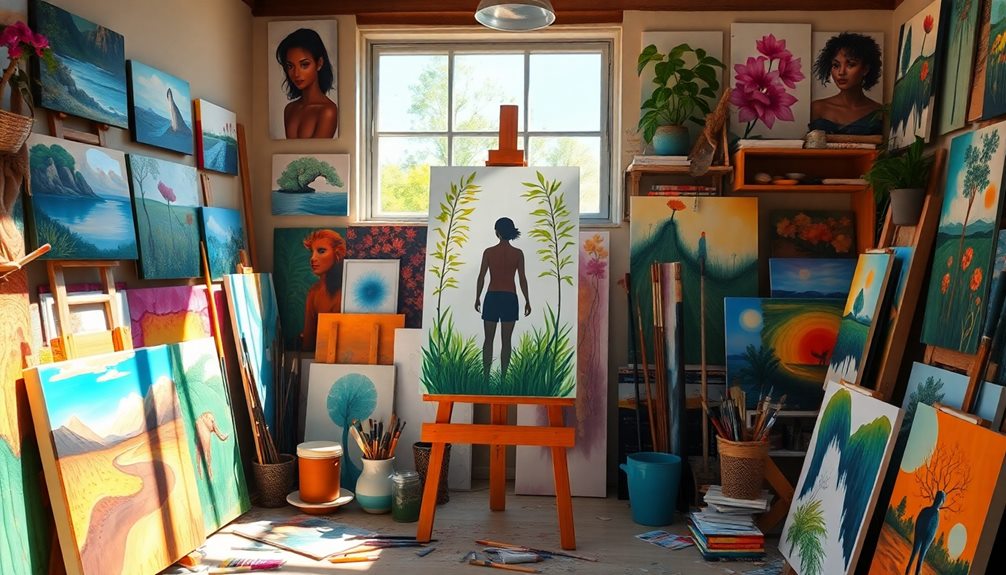
Building your artistic identity is a journey of self-discovery that invites you to experiment with various mediums and techniques. As you engage in different forms of art, you'll begin to define your unique voice in creative expression. This process not only helps in building artistic identity but also improves your mental well-being by enhancing self-awareness.
Reflecting on your personal experiences can inform your artistic choices, fostering deeper emotional understanding. Additionally, just like in the process of manifesting travel experiences, allowing yourself to feel good about your artistic aspirations can elevate your creative journey.
Don't be afraid to explore your creative side. Try painting, sculpting, or digital design—whatever resonates with you. Each experiment offers insight into your preferences and strengths, encouraging continuous growth and evolution as an artist.
Remember, your artistic identity isn't fixed; it can transform over time through practice and exploration.
Finding personal enjoyment in art is essential. When you integrate creative activities into your routine, it strengthens your artistic identity and makes the entire process more fulfilling.
Online courses and community forums can support you along the way, providing valuable resources to help you develop your skills from beginner to advanced levels. Embrace this journey; it's not just about creating art but about discovering who you are.
Resources for Artistic Exploration

A wealth of resources is available to help you investigate and expand your artistic skills. Numerous online platforms offer courses that cater to all levels, enabling you to immerse yourself in various artistic mediums and techniques at your own pace.
YouTube is a treasure trove of free tutorials and demonstrations, making the creative arts accessible to anyone keen to hone their skills or learn new methods.
Blogs dedicated to specific art forms, like watercolor painting, provide invaluable tips, techniques, and inspiration for enhancing your craft. These resources can guide you in your artistic exploration and empower you to express your emotions effectively.
Community forums allow you to connect with fellow artists, share experiences, seek feedback, and foster a supportive environment for growth.
Don't hesitate to experiment with different mediums, such as drawing, painting, or collage-making. This experimentation can lead to self-discovery and help you define your unique artistic voice, promoting your mental health.
Future of Art in Mental Health
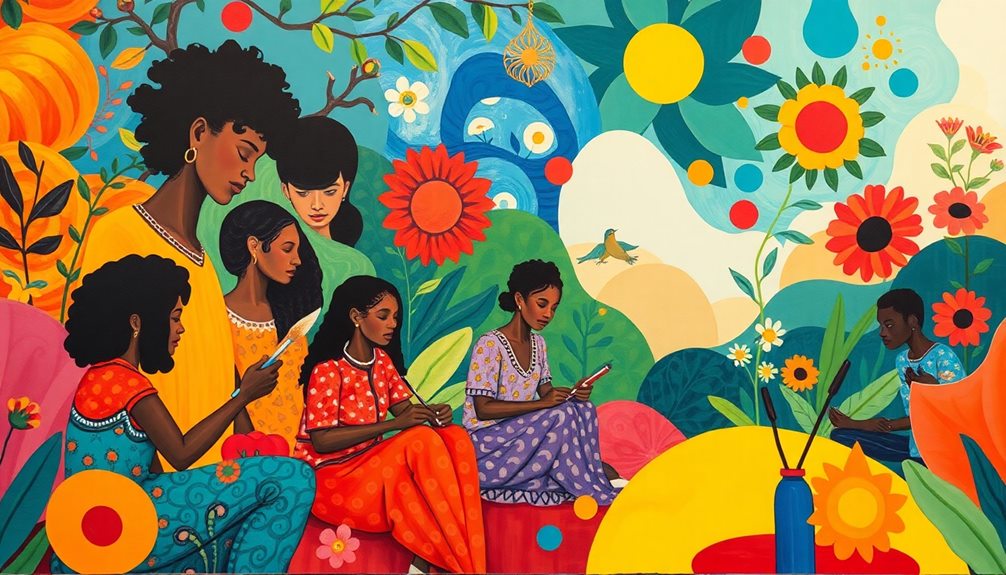
As we look ahead, you'll notice a significant shift towards digital art therapy, making creative expression more accessible than ever.
Community art initiatives are set to flourish, bringing people together and raising awareness about mental health.
Digital Art Therapy Expansion
The rapid expansion of digital art therapy is transforming how individuals access and engage with mental health resources. Thanks to the COVID-19 pandemic, digital art therapy platforms have become more widespread, allowing you to participate from anywhere, even in remote or underserved areas.
These programs often include interactive elements, giving you the chance to connect with experienced therapists through online sessions, which enhances your overall therapeutic experience.
Research shows that online art therapy can effectively reduce symptoms of anxiety and depression, creating a judgment-free space for your self-expression. You'll find that digital tools and art materials are often provided, ensuring you have everything you need to fully engage in the creative arts during virtual sessions.
This accessibility means you can explore your feelings and thoughts through art, regardless of your location.
Looking ahead, the future of digital art therapy is leaning towards hybrid models that combine in-person and digital experiences. This approach expands the reach and effectiveness of therapeutic art interventions, making it easier for you to find the support you need while embracing the healing power of creativity.
Community Art Initiatives
Community art initiatives are revolutionizing the way people engage with mental health support by promoting inclusivity and accessibility. These programs create supportive environments where discussions about mental health become more approachable. By partnering with local artists, communities enhance health awareness and education, making creative arts accessible to diverse populations.
| Initiative | Impact on Mental Health | Key Benefit |
|---|---|---|
| Art Workshops | Encourages expression and healing | Builds confidence |
| Community Murals | Fosters collaboration and unity | Strengthens social bonds |
| Fundraising Art Events | Raises awareness and funds for charities | Connects art and advocacy |
| Digital Art Platforms | Expands reach post-pandemic | Increases accessibility |
| Senior Art Programs | Reduces loneliness and isolation | Rebuilds social connections |
Future directions for community art initiatives include expanding research funding for art-based health interventions and developing digital platforms to engage wider audiences. These creative arts programs are not just about making art; they're about creating connections, reducing isolation, and advocating for mental health. By participating in these initiatives, you can directly contribute to a more supportive and understanding community.
Integrating Arts in Healthcare
Integrating arts into healthcare is revolutionizing the approach to mental health treatment. By incorporating creative arts therapies, health care professionals are addressing specific health goals while enhancing patient well-being.
Hospitals are increasingly adopting arts programs, including art installations and therapy sessions, which have proven effective in improving patient satisfaction and reducing stress for both healthcare providers and family members.
Engaging in creative activities can lead to faster recovery times, reduced anxiety, and elevated serotonin levels, making the arts a valuable adjunct to traditional medical treatments.
As the future of arts and mental health unfolds, we can expect increased research funding for art-based health interventions and the development of digital art therapy platforms—especially significant in light of the challenges posed by the COVID-19 pandemic.
Community art projects and partnerships with local artists are also essential. They promote health awareness and inclusivity, fostering a supportive environment for mental health discussions and interventions.
Frequently Asked Questions
How Does Art Impact Mental Health?
Engaging in creative activities helps you express emotions and process thoughts. It boosts your mood, lowers stress, and enhances self-awareness. By participating regularly, you can build connections and improve your overall mental well-being.
How Do Performing Arts Help Mental Health?
When you dance or sing, aren't you letting go of your worries? Performing arts help you express emotions, build connections, and alleviate stress, fostering confidence and resilience that enhance your overall mental well-being.
How Can Art Be Used as a Coping Mechanism?
You can use art as a coping mechanism by expressing your emotions creatively. Engaging in drawing or painting helps you process feelings, reduces stress, and provides a sense of accomplishment that boosts your overall well-being.
Why Is Art an Effective Form of Healing?
Art's an effective healing tool because it helps you process emotions, reduces stress, and enhances self-awareness. Engaging in creative activities boosts your mood, fosters mindfulness, and cultivates inner peace, promoting overall well-being and resilience.
Conclusion
Art isn't just a pastime; it's a pathway to healing. It helps you express emotions, relieve stress, and connect with others. Through creativity, you discover your identity, explore new possibilities, and foster mindfulness. As you embrace the transformative power of art, you open doors to understanding yourself and your mental health. So, whether you're painting, dancing, or writing, remember: each stroke, each note, each word contributes to a richer, healthier you.
-

 Interior4 months ago
Interior4 months agoHow to Start a Business in Interior Design
-

 Interior4 months ago
Interior4 months agoHow to Use Autocad for Interior Design
-

 Interior4 months ago
Interior4 months agoHow to Set up Interior Design Business
-

 Interior4 months ago
Interior4 months agoHow to Interior Design a Bedroom
-

 Texts5 months ago
Texts5 months agoExploring Art’s Transformation Through Material and Meaning
-

 Texts5 months ago
Texts5 months agoEngaging Illusions: The Art of LED Installation Experience
-

 Texts5 months ago
Texts5 months agoExploring the Dynamics of Artistic Practice and Public Engagement
-

 Texts5 months ago
Texts5 months agoExploring Financial Landscapes Through Art and Technology




